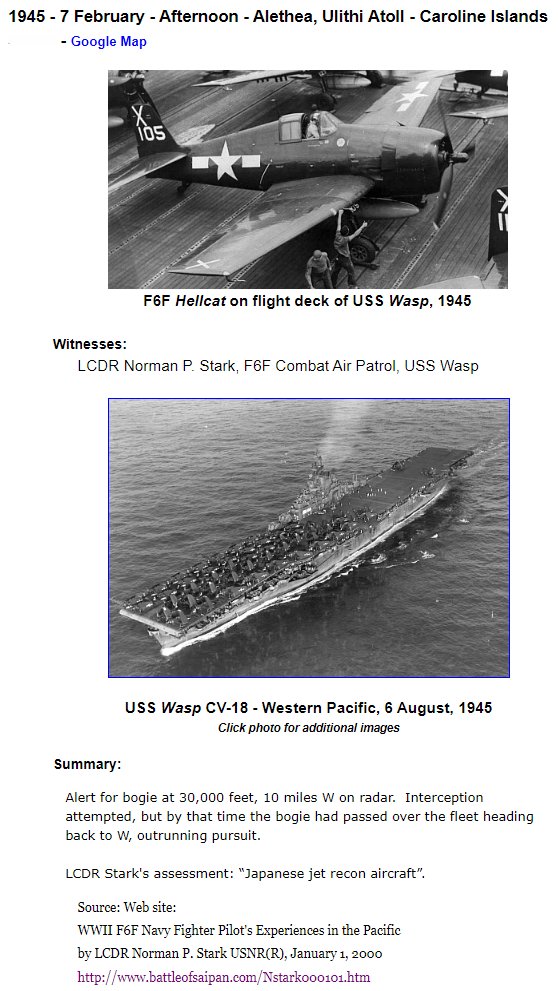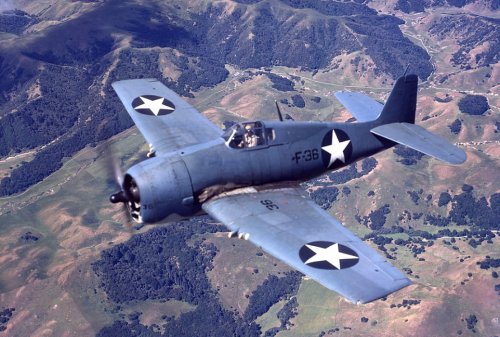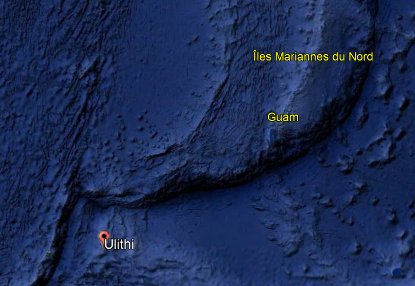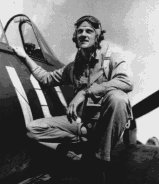ACUFO-1945-02-07-ULITHIATOLL-1
In 2000, Norman P. Stark told of his WWII experience as F6F “Hellcat” fighter plane pilot. Ufologists then found in his text a report telling that while Stark was based on Ulithi Atoll, on February 7, 1945, there came an alert. Stark told:
“During the afternoon, we had one alert. The Fighter Director indicated that a bogie had registered on the Radar screen at 30,000 feet some 10 miles to the west. We were to climb to 30,000 feet and intercept the bogie. By the time we got to 30,000 the bogie had passed over the fleet and turned and headed back west. The Fighter Director was constantly exhorting us to add speed and close on the bogie. We had all advanced our throttles past the normal stop into the range where we were using water injection, but the bogie continued to widen the distance. An object was seen, at a distance, moving away at great speed, but it could not be identified. In the years since, I have wondered if this could have been one of the early Japanese jets being used for reconnaissance.”
| Date: | February 7, 1945 |
|---|---|
| Time: | Afternoon |
| Duration: | ? |
| First known report date: | 2000 |
| Reporting delay: | 6 decades. |
| Country: | Micronesia |
|---|---|
| State/Department: | Ulithi |
| City or place: | Alethea |
| Number of alleged witnesses: | Several. |
|---|---|
| Number of known witnesses: | 1 |
| Number of named witnesses: | 1 |
| Reporting channel: | Personal narrative. |
|---|---|
| Visibility conditions: | Day. |
| UFO observed: | Yes. |
| UFO arrival observed: | No. |
| UFO departure observed: | Yes. |
| UFO action: | Flew away. |
| Witnesses action: | Intercept attempt in vain. |
| Photographs: | No. |
| Sketch(s) by witness(es): | No. |
| Sketch(es) approved by witness(es): | No. |
| Witness(es) feelings: | ? |
| Witnesses interpretation: | Possible Japanese jet plane. |
| Sensors: |
[X] Visual: Several.
[ ] Airborne radar: N/A. [X] Directional ground radar: Yes. [X] Height finder ground radar: Yes. [ ] Photo: [ ] Film/video: [ ] EM Effects: [ ] Failures: [ ] Damages: |
|---|---|
| Hynek: | DD RV |
| Armed / unarmed: | Armed, 6 Browning M2 12.7 mm machine guns. |
| Reliability 1-3: | 3 |
| Strangeness 1-3: | 2 |
| ACUFO: | Possible extraterrestrial craft. |
[Ref. nsk1:] NORMAN P. STARK:
My further acquaintance with Falalop Atoll came during this visit to the Alethea anchorage. While at the anchorage, each carrier had to provide fighter pilots to fly Combat Air Patrol over the area for one day. With many carriers in the Fast Carrier Task Force, this was not much of a problem. Our carrier's turn finally arrived, and MacBrayer's team was selected as one of the flights to participate on 7 February 1945. To ensure adequate protection to the anchored Fleet, three to four Divisions of fighters were kept in the air around the clock. At night, Night Fighters from the various carriers flew CAP.
The afternoon before we were scheduled to fly, we took a boat to Falalop. After looking around at the island's facilities we adjourned to the Officer's Club and had a fine dinner. As afternoon turned into evening, the liquor continued to flow. We all got a little tipsy. Having been without spirits for a time none of us had a tolerance for alcohol. We retired to our tent in the midst of a heavy rain. Needless to say we all had hangovers and were in mighty poor condition when the 0500 call came to rise, eat, and become airborne.
We ate a little breakfast and reported to the Operations shack for instructions. After being briefed, we packed our headaches and queasy stomachs into our planes and took off. Our assignment was to be on station at Angels 20 (20,000 feet) directly over the Fleet. At 20,000 we were on oxygen, and that helped reduce the pain in the throbbing heads.
About an hour after take off, the Fighter Director vectored us to a spot approximately 15 miles west of the Fleet where the Radar had picked up some Bogies (enemy planes). We set off at full speed to get the beggars. When we arrived at the point of contact, no planes were to be seen. Circling, we could see something flashing in the sunlight as it fell toward earth. After reporting our find to the Fighter Director, we were informed we had seen “Window” floating to earth. Window consisted of metallic chaff (metallic material cut into slim elongate strips) which when dropped out of a plane produced blips on the Radar screen resembling blips caused by planes. Window is dropped to lure Fighters from the area where they are providing a safety umbrella. The enemy plane, or planes, drop the Window and then leave the area at full speed. Shortly after we had been sent on the Wild Goose Chase, more Window was dropped in several places around the area, but the Fighter Director failed to respond to the same trick. All flights continued to orbit above the Fleet, but saw no enemy planes.
At Noon we landed to refuel and eat. That enabled us to walk around and stretch our legs. While we were waiting for the planes to be refueled, one of the mess boys brought our lunch in a jeep. He spread the delicious repast out on the hood of the jeep. One look at the meal was enough to sicken anyone. The sandwiches consisted of thick slabs of white bread with thick slices of SPAM between. No mayonnaise, no mustard, no anything - just dry bread and meat. The drink provided was a large pan full of a green liquid that tasted very much like citric acid. After a few bites were crammed down, we all crawled back into our planes for the afternoon patrol.
During the afternoon [of February 7, 1945], we had one alert. The Fighter Director indicated that a bogie had registered on the Radar screen at 30,000 feet some 10 miles to the west. We were to climb to 30,000 feet and intercept the bogie. By the time we got to 30,000 the bogie had passed over the fleet and turned and headed back west. The Fighter Director was constantly exhorting us to add speed and close on the bogie. We had all advanced our throttles past the normal stop into the range where we were using water injection, but the bogie continued to widen the distance. An object was seen, at a distance, moving away at great speed, but it could not be identified. In the years since, I have wondered if this could have been one of the early Japanese jets being used for reconnaissance.
At last the day came to a close. We landed and crawled from the planes, a mass of tired, sore muscles, after spending the day cramped in the cockpit on oxygen. A good meal at the Officer's Club and a pleasant boat ride back to the Carrier prepared us for a good night's sleep.
It might be well to clarify the above reference to “Water Injection.” Each F6F carried a 5 gallon tank containing a mixture of alcohol and water. When the throttle was advanced beyond the normal “Full Throttle” stop, the mixture of alcohol and water was injected into the carburetor along with the air-gas mixture. This mixture permitted a 15% increase in power available without doing any damage to the engine. A cooling effect was created by evaporation of the alcohol-water mixture.
[Ref. prt1:] JAN ALDRICH - "PROJECT 1947":
- Google Map [link to map.]

|
[Photo caption:] F6F Hellcat on flight deck of USS Wasp, 1945
Witnesses:
LCDR Norman P. Stark, F6F Combat Air Patrol, USS Wasp
[Photo caption:] USS Wasp CV-18 - Western Pacific, 6 August, 1945
Summary:
Alert for bogie at 30,000 feet, 10 miles W on radar. Interception attempted, but by that time the bogie had passed over the fleet heading back to W, outrunning pursuit.
LCDR Stark's assessment: “Japanese jet recon aircraft”.
Source: Web site:
WWII F6F Navy Fighter Pilot's Experiences in the Pacific by LCDR Norman P. Stark USNR(R), January 1, 2000
http://www.battleofsaipan.com/Nstark000101.htm
[Ref. tai1:] "THINK ABOUT IT" WEBSITE:
Date: Feb. 7, 1945
Location: Alethea, Pacific
Time: Afternoon.
Summary: Lt. Commander Norman P. Stark in a F6F on Combat Air Patrol with the USS Wasp. Alert for bogie at 30,000', 10 miles west on radar. Interception attempted but by that time bogie had passed over the fleet heading back to W, outrunning pursuit
Source: Web site: A WWII F6F Navy Fighter Pilot's Experiences In The Pacific. By LCDR Norman P. Stark USNR(R), Jan. 1, 2000. Witness: Japanese jet recon aircraft.
[Ref. fjh1:] FRANK JOSEPH:
During the early afternoon of February 7, 1945, while the warship cruised off the Ulithi atoll of Alethea in the Caroline Islands, Commander Norman P. Stark was informed of a rapidly incoming radar contact at thirty thousand feet, ten miles west. He immediately launched five Grumman F6F Hellcats, but the fighters' top speed of 391 mph was inadequate to intercept the supersonic bogey.
[Ref. get1:] GEORGE M. EBERHART:
February 7 - Afternoon. Several F6F fighters on patrol (one piloted by Ensign Norman P. Stark) from the USS Wasp aircraft carrier anchored at Ulithi Atoll in the Caroline Islands are told to investigate a radar target at 30,000 feet some 10 miles west of the fleet. Before they can reach altitude, the object moves back to the west at high speed. They catch a brief visual glimpse of it. (LCDR Norman P. Stark, “A WWII F6F Navy Fighter Pilot's Experiences in the Pacific,” Battle of Saipan, January 1, 2000)
The Grumman F6F “Hellcat” (photo below) was a carrier-based fighter developed to replace the F4F “Wildcat” in the United States Navy. Although the F6F was an extrapolation of the F4F, it was much more powerful with a Pratt & Whitney R-2800 2000 HP engine. Often called “Wildcat's big brother”, the Hellcat, like the F4U Corsair, was the main fighter plane of the U.S. Navy during the second part of the World War II.

|
Its armament was 6 Browning M2 12.7 mm machine guns, or, for the F6F-5N version, 2 20 mm cannons and 4 Browning M2 12.7 mm machine guns.
Ulithi atoll is located 660 km east-southeast of Guam, 1330 km north of Papua, in the Pacific.

|
Norman Stark (photo below) explains that after graduating from Pensacola Naval Air Training Station on 30 May 1944, he was sent to Melbourne, Florida for operational training in the F6F Hellcat fighter. On December 1, 1944, he flew to join the USS Hornet aircraft carrier at Ulithi Lagoon, home base of Air Group 11 (GAG-11). On December 4, 1944, his team was transferred to the USS Essex carrier, which had been hit by a Japanese Kamikaze pilot just before returning to Ulithi, and he flew several combat missions. He was based on the USS Wasp carrier on the Ulithi atoll at the time of the sighting ufologists noted.

|
“Window” was the Allied code name for chaff dropped by planes to create false radar echoes what the Japanese also did. This ruse had the limitation that the false echoes were obviously stationary, whereas in the observation noted here, it is obvious that the echo spotted by the ground radar was not stationary.
The strangeness of the case lies in the fact that Norman Stark had thought it must have been a Japanese jet plane; this is because of the speed of what they were pursuing.
At the time of the events, Norman Stark's idea was not absurd. But the Japanese had no operational jets during World War II. They had undertaken to build jet planes, based on the German Messerschmitt Me-262, but the only two projects were unsuccessful. The Nakajima “Kikka” only made one test flight, in Japan, on August 7, 1945. The single prototype of the Nakajima Ki-201 “Karyu” was never completed.
Possible extraterrestrial craft.
* = Source is available to me.
? = Source I am told about but could not get so far. Help needed.
| Main author: | Patrick Gross |
|---|---|
| Contributors: | None |
| Reviewers: | None |
| Editor: | Patrick Gross |
| Version: | Create/changed by: | Date: | Description: |
|---|---|---|---|
| 0.1 | Patrick Gross | December 27, 2023 | Creation, [nsk1], [prt1], [tai1], [get1]. |
| 1.0 | Patrick Gross | December 27, 2023 | First published. |
| 1.1 | Patrick Gross | April 17, 2024 | Addition [fjh1]. |